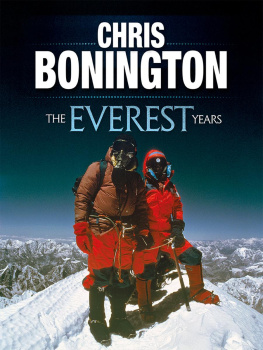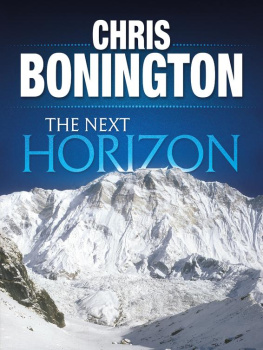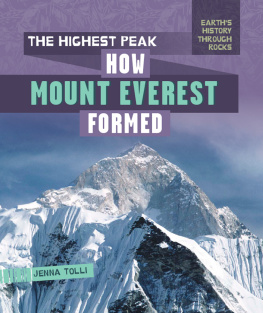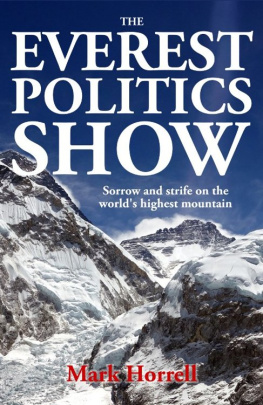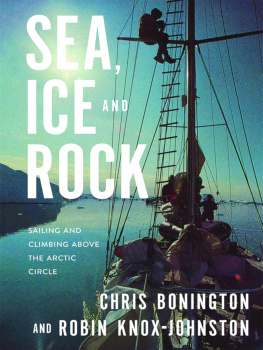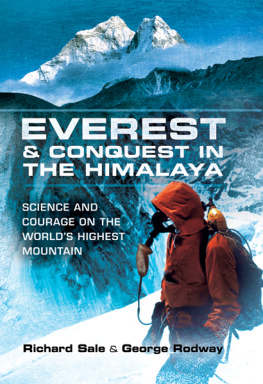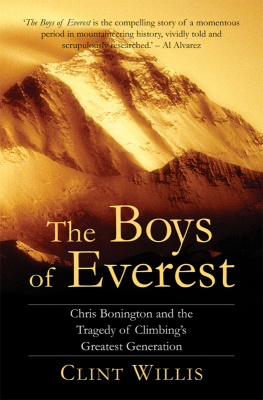Sir Chris Bonington - The Everest Years : the challenge of the worlds highest mountain
Here you can read online Sir Chris Bonington - The Everest Years : the challenge of the worlds highest mountain full text of the book (entire story) in english for free. Download pdf and epub, get meaning, cover and reviews about this ebook. year: 2017, genre: Home and family. Description of the work, (preface) as well as reviews are available. Best literature library LitArk.com created for fans of good reading and offers a wide selection of genres:
Romance novel
Science fiction
Adventure
Detective
Science
History
Home and family
Prose
Art
Politics
Computer
Non-fiction
Religion
Business
Children
Humor
Choose a favorite category and find really read worthwhile books. Enjoy immersion in the world of imagination, feel the emotions of the characters or learn something new for yourself, make an fascinating discovery.
- Book:The Everest Years : the challenge of the worlds highest mountain
- Author:
- Genre:
- Year:2017
- Rating:5 / 5
- Favourites:Add to favourites
- Your mark:
- 100
- 1
- 2
- 3
- 4
- 5
The Everest Years : the challenge of the worlds highest mountain: summary, description and annotation
We offer to read an annotation, description, summary or preface (depends on what the author of the book "The Everest Years : the challenge of the worlds highest mountain" wrote himself). If you haven't found the necessary information about the book — write in the comments, we will try to find it.
The Everest Years : the challenge of the worlds highest mountain — read online for free the complete book (whole text) full work
Below is the text of the book, divided by pages. System saving the place of the last page read, allows you to conveniently read the book "The Everest Years : the challenge of the worlds highest mountain" online for free, without having to search again every time where you left off. Put a bookmark, and you can go to the page where you finished reading at any time.
Font size:
Interval:
Bookmark:
To Louise and George
In writing this book, my third autobiographical work, I have covered my main expedition years. The theme is expeditioning in every different shape and size. Of some, I have already written books, which were as full and honest as I could make them at the time. I have therefore used a different approach for the expeditions of which I have already written, looking at them in a broader perspective, showing how they related to each other and bringing out what I felt were the highlights. Of the others I have gone into greater detail, reliving the entire experience.
The story is both my own and that of the people I have climbed with, of how a wide variety of teams have worked together to achieve a common end. In this respect expeditioning is a microcosm of life and work in general. This book certainly is the result of teamwork that has been built up over the years. Louise Wilson, my secretary from the 1975 Everest expedition, has taken on more and more, becoming a good friend and adviser, and has become my general editor of everything I write, from business letters to articles and books.
I owe a great debt to George Greenfield who has been so much more than my literary agent since 1969: he has helped steer all my expeditions through the maze of fundraising and contractual obligations, helping to make so many of my ventures possible, as well as advising me on my writing and coming up with a host of good ideas.
Over the years I have also built up a good understanding with Hodder and Stoughton, who have published all but one of my books over this period. I am particularly indebted to Margaret Body who has edited them all and become accustomed to my foibles. I also owe a great deal to Trevor Vincent who did the design work on this book, the fourth of mine on which he has worked.
I am deeply grateful to Carolyn Estcourt and Hilary Boardman for lending me the diaries of their husbands, Nick and Pete. These gave me a valuable extra perspective on the Ogre and K2 expeditions.
And finally I should like to acknowledge the constant love and support of my wife Wendy who has backed me to the full in all my expeditioning and given so much practical help and advice both on the text and the design of this book.
CB.
Theyd reached the summit, barely a hundred metres away and a metre or so higher than me. I had to squeeze out my last bit of willpower to join them. Push one foot in front of the other, pant hard to capture what little air and oxygen there was flowing into my mask. But had I enough left to get there? And then another careful, deliberate step along the corniced snow ridge to the top of the world.
A break in the cornice and, framed down to my right was the North-East Ridge, the route we had tried in 1982. Crazy ice towers, fierce snow flutings, a knife-edged ridge that went on and on. Friends of mine on the current British Everest Expedition were somewhere down there. Perhaps also were the bodies of Peter Boardman and Joe Tasker.
Another step, and the North-East Ridge was hidden by a curl of snow. This was where Pete Boardman had last seen Mick Burke in 1975. He and Pertemba were on their way down, Mick was going for the summit on his own. He never came back. My head was filled with thoughts of lost friends, of Nick Estcourt who forced the Everest Rock Band and died on K2, of Dougal Haston who went to the summit of Everest with Doug Scott, and died skiing near his home in Switzerland.
And then suddenly I was there. Odd, Bjrn and Pertemba were beckoning to me, shouting, their voices muffled by their oxygen masks. I crouched in a foetal position and just cried and cried in great gasping sobs - tears of exhaustion, tears of sorrow for so many friends, and yet tears of fulfilment for something I had so much needed to do and had done with people who had come to mean a great deal to me. I had at last reached the summit of Everest.
It was 21 April 1985 and in the next ten days the Norwegian Everest Expedition was to place seventeen climbers on the summit - the highest number on a single expedition. We had also completed our ascents earlier in the season than any previous expedition. Judged solely as records these would be fairly empty achievements. Youve got to look deeper to under-stand their significance. I suspect that every climber in the world dreams of standing on the highest point on earth; certainly every climber who joins an expedition to Everest does and that includes quite a few of the Sherpa high-altitude porters as well. If you judge success, therefore, in terms of the sum of individual satisfaction and fulfilment, there is a very real point in getting as many to the summit as possible. Getting there quickly both increases the chance of success and reduces the time that the team is exposed to danger.
There were five expeditions attempting Everest by different routes in the spring of 1985 and the speed with which we were able to run out the route undoubtedly contributed to the fact that we were the only successful expedition. The others were overtaken by the bad weather that occurred later in the season. We were fast because we had a superb and very strong Sherpa force and because the climbers and Sherpas became welded into a closely knit team who worked happily, and therefore effectively, together.
It was this that made the expedition such a success, not just in terms of making records, but also in terms of personal satisfaction for every member of the team. I have been on expeditions that have reached their summit and yet there has been little sense of success because the group had failed to work together and there was acrimony rather than friendship at the end of the experience.
Unless you always go alone, the essence of climbing is teamwork. You are entrusting your life to others, on a rock climb to your partner holding the other end of the rope, but on a higher mountain it becomes more complex. There you need to trust the judgement of others in choosing a route, or perhaps their ability to give support from a lower camp. There is a constant interplay of decision-making, be it between two climbers on a crag in the Lake District or amongst thirty distributed between a series of camps on Everest.
Two or possibly four people climbing together, even on a major Himalayan peak, can reach a decision through discussion. There is no need of a hierarchy or official leader, though almost always a leader does emerge one person who has a stronger personality or who is particularly equipped to deal with a specific problem encountered. In this last respect the lead can pass around the group during the course of a climb. Mountaineering, like every other activity, is a development and learning process about the mountains, ones personal ability and, perhaps most important of all, ones relationship with others.
This book covers the last fifteen years, which for me, have been dominated by expedition climbing. Everest has been a recurrent theme, a magnet that has drawn me again and again, not just because I wanted to reach its summit personally, but because of the scale of its challenge, the strength of its aura.
I had my first glimpse of Everest in 1961, on my way to climb Nuptse. In those days you had to walk all the way from Kathmandu; there was no airstrip at Luglha and the road ended just outside the city. On the way in we saw just one other European, Peter Aufschnaiter, who had been with Heinrich Harrer in Tibet after they had escaped from a British internment camp in northern India. These were the days before trekkers and tourists. There were a few little teashops on the path side for the porters carrying loads and trade goods, but all you could buy were cups of tea and perhaps a few dry biscuits.
The first glimpse of the worlds highest mountain comes as you climb the winding track that leads up to Namche Bazaar from the bottom of the Dudh Kosi valley. You come to a bend in the path on a small spur and suddenly, through the shrubs and small birch trees, you can see Everest framed by the precipitous sides of the Dudh Kosis gorge, part hidden by the great wall of Nuptse that acts as its outer rampart.
Font size:
Interval:
Bookmark:
Similar books «The Everest Years : the challenge of the worlds highest mountain»
Look at similar books to The Everest Years : the challenge of the worlds highest mountain. We have selected literature similar in name and meaning in the hope of providing readers with more options to find new, interesting, not yet read works.
Discussion, reviews of the book The Everest Years : the challenge of the worlds highest mountain and just readers' own opinions. Leave your comments, write what you think about the work, its meaning or the main characters. Specify what exactly you liked and what you didn't like, and why you think so.

